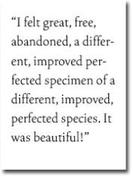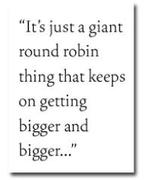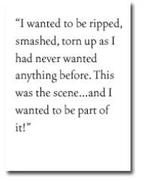Addiction and the Humanities, Volume 1(13) – Is addiction-related behavior involuntary? Go ask Alice
It seems inarguable that the excessive behavior of people suffering with addiction is not voluntary in the usual sense. Normally we expect that people perform behaviors they believe will fulfill their desires. For example, if one desires to be with a friend she will drive to her house or take whatever steps necessary to fulfill that desire. Yet people with addiction keep performing the same actions that have resulted in increasingly negative consequences. It is difficult to imagine that people who perform these behaviors actually desire the consequences that reliably ensue. On the other hand, addictive behavior does not seem to be entirely involuntary, either, in the way that tremors or stomach pains are involuntary. Addictive behavior requires planning, as well as goal-directed, controlled bodily movements such as driving to a bar or casino. Heyman (1996) suggested that this apparent contradiction is due to the fact that people, particularly those with addiction, often have different, even mutually exclusive desires at different times and in different situations. Therefore, we might understand the behavior of people with addiction as voluntary in that it is performed in order to fulfill the agent’s momentary desires and involuntary in that the intense and frequently contradictory desires themselves are beyond control.
“Go ask Alice” (1971) is based on the diary of a teenage girl struggling with drug addiction. The detailed and eloquent descriptions of her day-to-day experiences provide an opportunity for the reader to gain understanding of addiction through the eyes of a sufferer and witness how the downward spiral of the disease can play out in day-today life. The diary also serves as a dramatic illustration of the context-related shifting of desires involved in addiction. The entries reveal repeated cycles of a sincere desire never to use drugs again, followed by acute periods of wanting to use as much and as many mind-altering drugs as possible. Usually some crisis precipitated the avoidance phase and witnessing drug use by others triggered the drug-seeking phase.
We see from her diary entries before she started using drugs that Alice was a typical, shy girl from a close-knit, middle class family. Her first drug experience, ironically, was truly unintentional; after drinking a Coke at a party she found out someone had laced it with LSD. “I felt great, free, abandoned, a different, improved perfected specimen of a different, improved, perfected species. It was beautiful!” Despite her positive experience, Alice soon became wary of drugs, writing, “I hereby solemnly promise that I will from this very day forward live…so that I can be proud of myself!” Thus, cycling between avoidance and craving began at her very first drug experience.
At a party the next week she decided to take “one last trip,” and within a month she was involved with the “drug crowd” at school. In exchange for drugs, she sold LSD for this crowd to kids as young as ten. Again, she soon decided to stop using, but felt that her involvement with drug users would make it impossible to change. To escape this involvement, she ran away with a friend. Although it seems unlikely that leaving her home and family would allow her to quit, the sincerity of her desire to stop using was manifested by a period of abstinence from drugs despite the difficulty of living independently at age fifteen. She showed insight into her situation, noting that drug users usually start selling to other people, that “it’s just a giant round robin thing that keeps on getting bigger and bigger,” and that “drugs are the root cause” of her problems. She and her friend “gave [their] sacred oath” never to use again. Although earlier expressions of the desire to quit seemed somewhat ambivalent, at this point she exhibited an unambiguous desire to stop using and took steps she believed would allow her to fulfill this desire.
Nevertheless, the next situation in which she witnessed drug use resulted in a drastic change in perspective. Her resolve to quit succumbed to a strong desire to get high: “I wanted to be ripped, smashed, torn up as I had never wanted anything before. This was the scene…and I wanted to be part of it!”. For the next week she was enthusiastic about being “back on the merry-go-round.” During this period she planned and schemed to acquire drugs, showing no evidence of her former conviction to stay clean. Her drug use at this point was thus quite purposeful. Alternating periods of avid drug seeking and use followed by sincere convictions to quit became increasingly extreme as her desire for drugs and the resulting sense of fear and shame became more intense.
On one hand Alice’s struggles with addiction clearly involved loss of control. The argument here, based on Heyman’s perspective on addiction, is that the involuntary component of her addiction was not the drug use itself, but the desire to use drugs. Her drug use resulted in brain changes manifested by an intense and irrational desire to engage in addiction-related behavior. Once this desire set in, using drugs was the intentional fulfillment of this desire.
Alice’s story is quite typical of addiction in that her initial experience with drugs was positive and the progression of the disease was marked by repeated cycles of abstinence and relapse as both her craving for drugs and her wish to stop became more intense. However, in contrast with conventional perspectives of addiction, which hold that addictive behavior is limited to one or two objects of addiction, she never developed an addiction for a specific substance. She used eight different drugs that she seemed to consider interchangeable. Her story is thus consistent with the “syndrome model” of addiction (see WAGER 10(1)), which posits that disordered relationships with certain behaviors or substances are manifestations of a single underlying disorder. From this perspective it is plausible for someone with addiction not to be dependent on a particular behavior or substance.
Just as Alice’s descriptions of her daily struggles allow for a rare glimpse into the personal experience of addiction, the outcome of her story illustrates the potential tragedy of the disease: Within a year of her first drug experience Alice died of an overdose. It is not clear whether this last action was precipitated by a desire to get high or to end her struggles.
What do you think? Comments can be addressed to Cheryl Browne.
References
Anonymous (1971). Go ask Alice. New York: Simon & Schuster.
Heyman, G. (1996). Resolving the contradictions of addiction. Behavioral and Brain Sciences, 19(4), 561-610.


